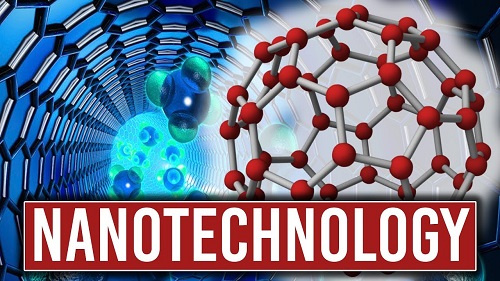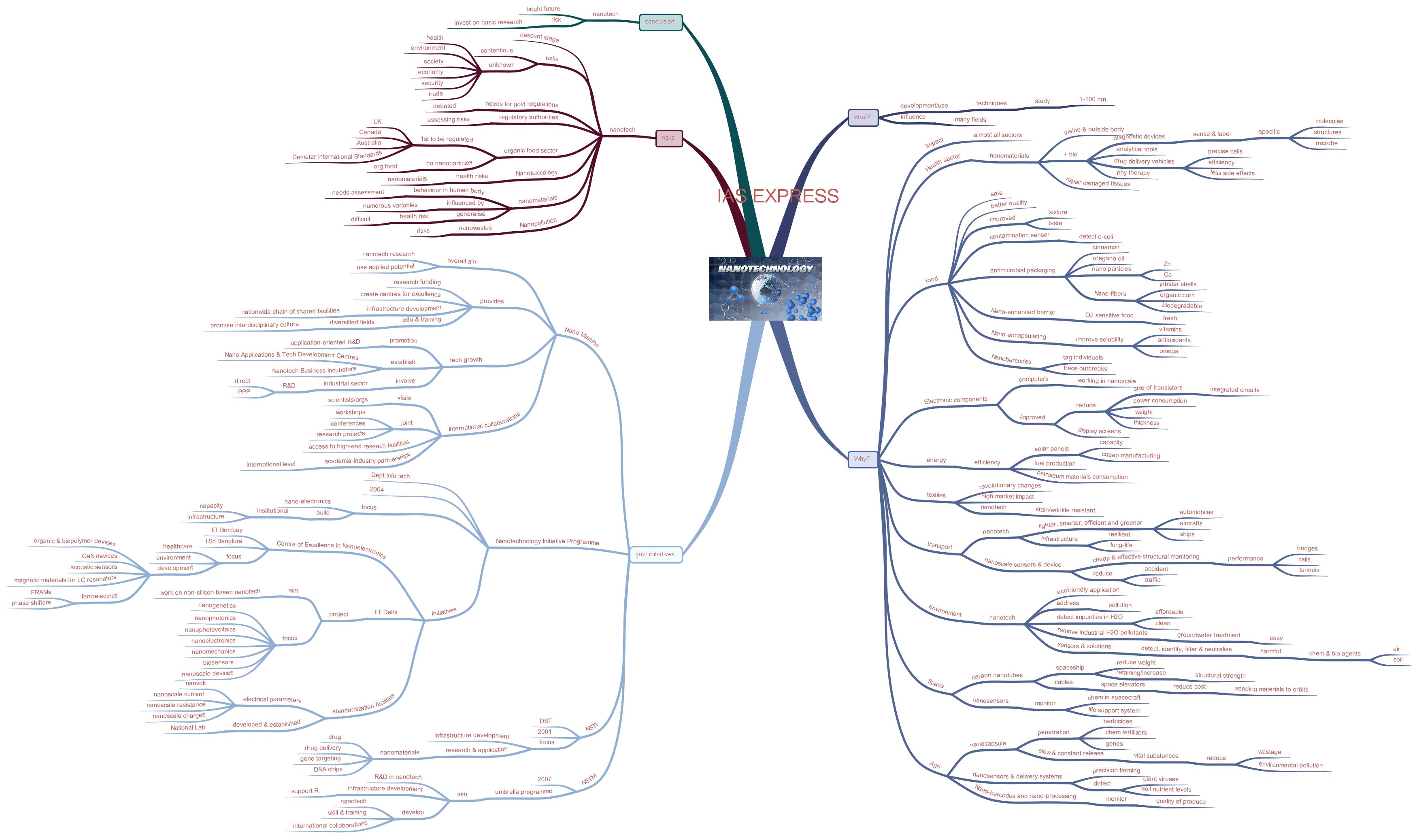Nanotechnology in India – Advantages, Disadvantages & Government Initiatives

* Updates at the bottom
Nanotechnology holds enormous potential for human development and it is even more so for India. It can address the current problem of water pollution, disease diagnosis, etc. Despite the positive potential, very few in India are willing to research it and most of the funding is from the government. The private sector provides little to no funding for this field. Even the career prospects in this field are very limited. Thus, a multipronged approach should be implemented to ensure that the potential can be fully leveraged for the betterment of all.
What is nanotechnology?
- When the materials at their atomic and molecular levels are modified, some unusual and useful properties are generated.
- Since the dimensions of the atoms and molecules are in nanometres, this technology is called nanotechnology. The resulting materials are called nanomaterials.
- Nanotechnology is the development and the use of techniques to study physical phenomena and develop new devices and material structures in the physical size range from 1 to 100 nanometres (nm), where 1 nanometre is equal to one billionth of a meter.
- Nanotechnology influences almost all areas of our lives, including materials and manufacturing, electronics, computers, telecommunication and information technologies, medicine and health, the environment and energy storage, chemical and biological technologies and agriculture.
Why do we need it?
As previously mentioned, nanotechnology is a new and emerging field that has an impact on almost all sectors of the economy. The research on nanotechnology has spread across many fields like health, food, computing, textile, energy, transport, space, agriculture, etc.
Health sector:
- The application of nanotechnology in the health sector is wide-ranging.
- Nanomaterials can be used inside and outside the body.
- Thus, the integration of nanomaterials with biology has led to the development of diagnostic devices, analytical tools, drug delivery vehicles, and physical therapy applications.
- This technology has led to the possibility of delivering drugs to precise cells, ensuring greater efficiency and lesser side effects.
- Nanomaterials have also given the scope for repairing damaged tissues since the cells can be artificially produced using this technology.
- This technology has currently become an important diagnostic tool since it can sense and label specific molecules, structures or microorganisms.
Food Industry:
- Nanotechnology provides the potential for safe and better quality food and improved texture and taste of the food.
- A contamination sensor, using a flash of light can reveal the presence of E-coli.
- Antimicrobial packaging made out of cinnamon or oregano oil or nanoparticles of zinc, calcium, etc., can kill bacteria.
- The nano-enhanced barrier can keep oxygen-sensitive food fresh.
- Nano-encapsulating can improve the solubility of vitamins, antioxidants, healthy omega, etc.
- Nano-fibres made of lobster shells or organic corn can allow for antimicrobial packaging while being biodegradable.
- Nanobarcodes are used to tag individual products and trace outbreaks.
Electronic components:
- Computers are already working on a nanoscale.
- Nanotechnology has greatly improved the capacity of electronic components by:
- Reducing the size of the integrated circuits’ transistors
- Improving the display screens of the electronic devices
- Reducing power consumption, weight, and thickness of the electronic devices.
Energy-efficient:
- This technology can improve the efficiency of the existing solar panels. It can also make the manufacturing process of solar panels cheaper and efficient.
- It can improve the efficiency of fuel production and consumption of petroleum materials.
- It is already being made use of in many batteries that are less-flammable, efficient, quicker-charging and are lightweight and higher power density.
- Broadly, it has the potential to improve the existing technologies to be more efficient with less consumption of energy.
Textile industry:
- Nanotechnology has already made revolutionary changes in the textile industry and is estimated to make a market impact worth hundreds of billions of dollars.
- Nanoscience has now produced stain and wrinkle resistant cloths and may further improve upon the existing innovations.
Environment:
- The nanotechnology has numerous eco-friendly applications.
- It has the potential to address the current problem of pollution.
- It can provide for affordable, clean drinking water through swift detection of impurities and purification of water.
- The nanotechnology can be used to remove industrial water pollutants in the groundwater through chemical reactions at a cheaper rate than the current methods that need pumping of the groundwater for treatment.
- Nanotechnology sensors and solutions also have the potential to detect, identify, filter and neutralise harmful chemical or biological agents in the air and soil.
Transport:
- Nanotechnology contributes to manufacturing lighter, smarter, efficient and greener automobiles, aircraft and ships.
- It also allows various means to improve transportation infrastructures like providing resilience and longevity of the highway and other infrastructure components.
- The nanoscale sensors and devices can also provide for cheap and effective structural monitoring of the condition and performance of the bridges, rails, tunnels, etc. They can also enhance transportation infrastructure that makes the drivers avoid collisions and congestions, maintain lane position, etc.
Space:
- Materials made of carbon nanotubes can reduce the weight of the spaceships while retaining or increasing the structural strength.
- They can also be used to make cables that are needed for the space elevator. Space elevators can significantly reduce the cost of sending materials to the orbit.
- The nanosensors can be used to monitor the chemicals in the spacecraft to look into the performance of the life support system.
Agriculture:
- The nanocapsule can enable effective penetration of herbicides, chemical fertilizers, and genes into the targeted part of the plant. This ensures a slow and constant release of the necessary substance to the plants with minimised environmental pollution.
- The nanosensors and delivery systems can allow for precision farming through the efficient use of natural resources like water, nutrients, chemicals etc.
- The nanosensors can also detect the plant viruses and soil nutrient levels.
- Nano-barcodes and nano-processing could also be used to monitor the quality of agriculture produce.
What are the initiatives taken by the government to promote/utilize it?
Nano Mission:
- It is an umbrella programme aims for the overall development of research in the field of nanotechnology and to make use of its applied potential for economic development.
- It strives to promote basic research through funding to individual or group of scientists and create centres for excellence for promoting skills and education in this field.
- Infrastructure development is vital in this field and requires expensive equipment like Optical Tweezers, Nano Indenter, Transmission Electron Microscope (TEM), Atomic Force Microscope (AFM) etc. For the optimum use of these expensive infrastructures and technologies, it has proposed to establish a nationwide chain of shared facilities.
- For the technological growth in this field, this mission has proposed
- The promotion of application-oriented research and development projects
- It has also proposed the establishment of Nano Applications and Technology Development Centres, Nanotechnology Business Incubators etc.
- It is also promoting the involvement of the industrial sector into nanotechnology research and development either directly or through Public-Private Partnership ventures.
- The Nano Mission also focuses on providing education and training in diversified disciplines to ensure the promotion of interdisciplinary culture in this field.
- International collaborations under this mission allow for visits of scientists and organisations from abroad and joint workshops, conferences, research projects with other nations. It also ensures access to high-end research facilities in foreign countries and the establishment of joint centres for excellence. It also forges academia-industry partnerships at the international level when required.
Nanotechnology Initiative Programme
- It comes under the Department of Information Technology.
- It was initiated in 2004 with an emphasis on nano-electronics.
- It is focusing on building the institutional capacity and infrastructure for research and development and human resource development in the area of nano-electronics.
- The initiatives taken under this programme include:
- The Centre of Excellence in Nanoelectronics was established at IIT Bombay and IISc Banglore. They are focusing on healthcare and environmental monitoring, development of organic and biopolymer devices, GaN devices, acoustic sensors, magnetic materials for LC resonators, ferroelectrics for FRAMs and phase shifters etc.
- IIT Delhi has recently initiated a project with an aim to work on non-silicon based nanotechnology. The primary focus will be given to nano-genetics, nanophotonics, nano-photovoltaics, nanoelectronics, nanomechanics, biosensors, and mesoscale devices.
- Nanotechnology needs to be measure nano dimensions, nano electrical properties, etc. Thus, standardization facilities for electrical parameters like nanvolt, nanoscale current, nanoscale resistance, and nanoscale charges have been developed and established in the National Laboratory.
Nano Science and Technology Initiative (NSTI)
It was set up by the Department of Science and Technology (DST) in 2001 to focus on issues related to infrastructure development, research and application programmes related to nanomaterials including drugs, drug delivery, gene targeting and DNA chips.
Nano Science and Technology Mission (NSTM)
NSTM, launched in 2007, is an umbrella programme that aims to promote research and development in nanotechnology. The objectives include the promotion of research, infrastructure development to support the research, develop nanotechnology, human resources, and international collaborations.
What are the risks of nanotechnology?
- The nanotechnology may pose a potential risk to the environment, health and other safety issues.
- Since this field is still at its nascent stage, the likely risks are contentious.
- As for whether or not this technology requires special government regulation, the issue is still debated.
- The regulatory authorities like the US Environmental Protection Agency and the Health and Consumer Protection Directorate of the European Commission have started assessing the potential risks posed by the nanoparticles.
- The organic food sector is the first to be regulated so that the engineered nanoparticles are excluded from the organic produce. It has been implemented in Australia, UK and Canada as well as all the food certified under the Demeter International Standards.
- Nanotoxicology is the study of potential health risks of nanomaterials.
- The human body can easily take up the nanomaterials as they are small in size.
- However, there is a need for detailed research on how it would behave inside an organism. The behaviour of nanoparticles based on their size, shape and surface reactivity must be thoroughly analysed before launching them into the market.
- The nanomaterials that influence toxicology include chemical composition, shape, surface structure, surface charge etc.
- Due to the numerous variables influencing the toxicology of the nanomaterials, it is difficult to generalise the health risk associated with them.
- Thus, each new individual nanomaterial must be assessed and all material properties must be taken into consideration.
- Nanopollution is the generic term that is used to describe the waste generated by the nanodevices or nanomaterials during the manufacturing process.
- Nanowastes may be of risk due to their size and different properties and interactions. Since the man-made nanoparticles are not naturally made, living organisms may not have the appropriate means to deal with them.
- The risk of nanotechnology on health, environment, society, economy, security, and trade is not yet fully assessed. This in itself is a threat.
Conclusion
The nanotechnology provides a bright future for the humankind. However, much is yet to be known about its impacts and risks. The government, before indulging in the promotion and launch of this new technology, must invest more in the basic research to understand this field.
Test Yourself
What are the steps that can be taken by the government to promote and utilize nanotechnology? (250 words)
Updates
Results of the government’s initiatives
- India has published around 23,000 papers in nanoscience.
- India ranked third in papers published in 2018 following only the USA and China.
- There have been several patent applications in this field.
If you like this post, please share your feedback in the comments section below so that we will upload more posts like this.


